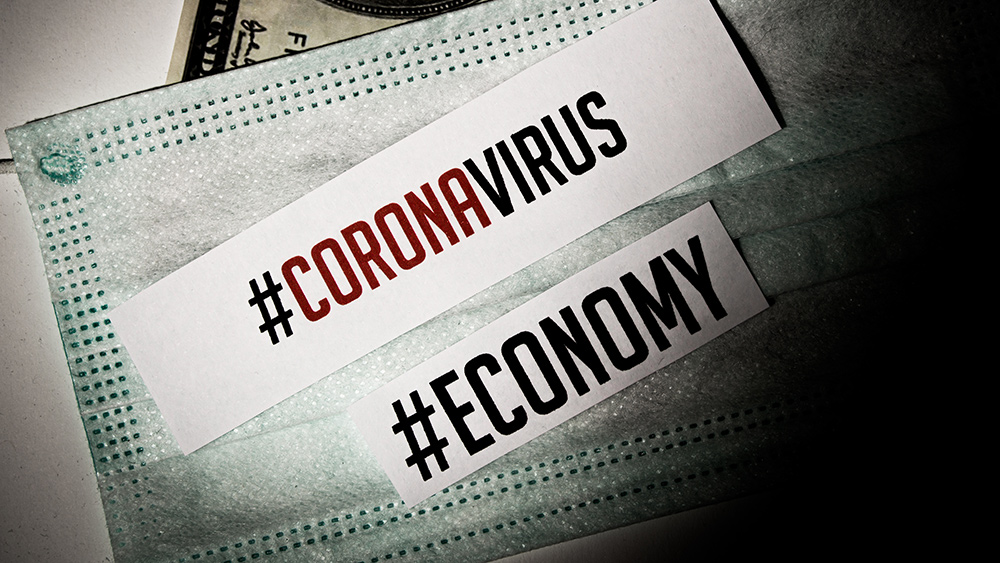Coronavirus lockdowns are “overly blunt and costly” … economists and health experts point to a more effective way
08/30/2020 / By Zoey Sky

As the coronavirus (COVID-19) pandemic spread like wildfire throughout America, the country was forced to implement something it has never tried before: Blanket business shutdowns.
However, this tactic has resulted in a deep recession. While the pandemic spreads, economists and health experts suggest that it may be time to try a different and more effective plan.
A poorly understood disease and ineffective measures
Across the globe, governments in several countries enforced strict restrictions on outdoor activities and businesses to prevent the spread of the disease. But this approach resulted in what is now considered the world’s “deepest peacetime slump since the Great Depression.”
In America alone, 13 million people lost their jobs while at least 400 million jobs were lost worldwide. The International Monetary Fund reports that global output could fall five percent in 2020, an outcome that will be even worse than during the financial crisis.
While economies struggled and many lives were lost due to the pandemic, policymakers believed that they had to make difficult choices and that the economic crisis was a side effect of the pandemic.
When the pandemic struck, nonessential businesses closed and people were told to stay home. However, these measures were enforced without the extensive analysis of benefits and risks that is required before a new medical treatment because the world wasn’t prepared for the coronavirus pandemic.
Experts didn’t have enough time to gather the necessary evidence so they focused on saving as many lives as they could.
Discipline is key to preventing a worst-case scenario
Many months later, data reveals that pandemic lockdowns were “an overly blunt and economically costly tool.”
In many countries, lockdowns were politically difficult to enforce long enough to eliminate COVID-19. Data also suggests that there are other ways to effectively slow the spread of the epidemic without a significant economic impact.
As coronavirus cases skyrocketed in America, experts implored policymakers to reconsider more targeted restrictions and interventions instead of dealing another crippling blow to the economy with extended lockdowns.
James Stock, a Harvard University economist, warned that the U.S. is teetering on the edge of “an economic catastrophe.” Fortunately, being disciplined can help the country avoid the worst.
Stock is working with Michael Mina, a Harvard epidemiologist, and other experts to model how to prevent a surge in deaths and economic risks while employing a lockdown.
During pandemics, the economy suffers not because of people who are already sick but because of healthy people who want to avoid getting infected, such as consumers and employees who stay home while businesses rearrange or suspend production.
Because people stay indoors by choice, the economic impact is unavoidable even if governments in different countries enforce restrictions.
The virus must be controlled for the economy to recover
Even experts struggle to find a clear distinction between voluntary and government-ordered effects.
In a study conducted by economists Austan Goolsbee and Chad Syverson at the University of Chicago, findings suggested that government restrictions only made up 12 percent of the decline in consumer mobility in America.
Individual choices bore more weight and were linked to fears of getting infected. More people voluntarily stayed at home even before legal orders were enforced. Decisions to stay indoors were also highly influenced by the number of reported coronavirus deaths. Shoppers avoided busier stores and sought smaller, less busy stores.
But in a separate study, a research team led by economists Kosali Simon at Indiana University and Bruce Weinberg at Ohio State found that government restrictions were behind a shocking 60 percent loss of employment between January and April.
The researchers posited that this was due to social distancing policies in certain states and other factors common to the whole country, like fear of infection or the floundering global economy.
Sweden’s unique approach
Unlike other countries that imposed lockdowns, Sweden only enforced modest restrictions so its hospitals could effectively handle existing COVID-19 cases. JPMorgan Chase & Co reported that while Sweden recorded more deaths per capita neighboring Denmark, it had fewer fatalities than Britain. Sweden’s economy also survived the impact of the pandemic.
The rest of the world was in awe of Sweden’s current infection and death rates, which are as low as the rest of Europe’s. Experts theorized that it is pursuing herd immunity or the point when enough of the population is immune, either because of prior exposure or vaccination. This ensures that person-to-person transmission gradually declines until the epidemic dies out.
However, experts haven’t agreed on where that point is, in Sweden or anywhere else.
When March rolled around, it was too late for America to try East Asia’s test-and-trace strategy since the Centers for Disease Control and Prevention (CDC) didn’t meet the timeline for the initial development and distribution of tests.
Limited testing capacity also resulted in a lot of cases that went undetected for months. It didn’t help that President Donald Trump downplayed testing. To date, the country conducts fewer than 20 tests for every confirmed case, unlike more than 500 in Taiwan and South Korea at their peaks.
Britain abandoned the Swedish strategy in mid-March after a forecast from researchers from Imperial College London said that if people didn’t practice social distancing, 81 percent of the population would eventually be infected. The estimate also suggested that at least 510,000 people would die in Britain, with 2.2 million casualties in America.
While the estimates are high, experts noted that it will take less than 81 percent of a population to reach herd immunity. Despite the uncertainty, the figures helped convince leaders in Britain and America to enforce lockdowns.
China’s methods aren’t applicable to Western democracies
Certain countries effectively suppressed coronavirus cases with lockdowns. For example, China contained the epidemic in Hubei province. The country has since controlled subsequent outbreaks in other areas using sweeping quarantine and surveillance methods, but these aren’t as easy to enforce in Western democracies like America.
The U.S. is either unable or unwilling to follow China’s authoritarian bent. In March, Trump expressed his hopes that the lockdown wouldn’t last for several months.
By the end of March, Trump’s health advisers suggested that only one more month of restrictions was needed. In mid-April, the president’s health advisers issued guidelines for when states with lockdowns should reopen, together with 14 days of declining cases and the ability to test and trace patients experiencing flu-like symptoms.
Mark Ghaly, California’s secretary of health and human services, said that the state’s strategy remained the same: To get infections low enough so California’s systems can treat sick people.
Ghaly said that the pursuit of total suppression was considered, but this approach required an “early, nationwide commitment,” which would have been difficult due to the clashing views of American citizens.
He added that there are other factors to consider, like the impact of lockdowns on families. The economy, struggling businesses, unemployment rates and mental health should also be taken into account, added Ghaly. (Related: Food prices rise to dangerous levels as “a second wave of layoffs” hits the U.S. economy.)
Mina believes that when the pandemic was in its early stages, America could have prioritized the economy like Sweden did and accept the deaths.
On the other hand, the country could have focused on health by enforcing a lockdown until new infections were so low that testing and tracing could control new outbreaks. Northeastern states like Rhode Island used this tactic to deal with the pandemic.
But the rest of America remained undecided, which cost many lives and a great economic cost. Mina noted that this also resulted in many businesses being forced to close permanently and leave countless citizens unemployed during the worst pandemic in the history of the country.
Learn from past mistakes, urge experts
Things might get worse before they get better, but Mina suggests trying alternatives to lockdowns such as measures that can effectively “maximize lives saved while minimizing economic and social disruption.”
For example, social distancing policies could factor in risks that vary by age. Since COVID-19 is particularly fatal for the elderly, isolating residents in nursing homes can help prevent further infections.
On the other hand, fewer children have died from coronavirus than from flu in 2020. McKinsey & Co. suggests that if schools don’t reopen until January next year, many low-income children will lose at least a year of education. This could result in four percent lower lifetime earnings, further widening the gap between the upper, lower and middle classes.
Experts also note that closely monitoring “super-spreader” events can help prevent infections. These events include dense indoor gatherings with talking, singing and shouting, especially bars, nightclubs, sporting events, religious services and weddings.
Both the World Health Organization (WHO) and the U.S. Surgeon General claimed that wearing face masks wasn’t necessary, but masks may be the most cost-effective intervention. According to the CDC, wearing masks can limit the spread of flu by preventing someone from transmitting the disease.
Goldman Sachs Group Inc. has found that enforcing a universal mask mandate in the country can save five percent of gross domestic product by substituting for strict lockdowns.
Public health researchers and economists also suggest that ramping up testing is key to safely reopening the economy without a vaccine, which may do more harm than good. Paul Romer, a Nobel laureate economist, posited that America could restore $1,000 in economic activity by spending only $10 on tests.
Mina commented that an easy-to-use paper-strip test can detect the virus using a sample of saliva within minutes. While this method is less accurate, it’s much faster and cheaper than sending samples to labs. Assuming 50 to 60 percent of the population in hot spots took paper-strip tests daily, the country has a chance at controlling the spread of COVID-19.
Mina and Stock’s team has also drafted a “smart” reopening plan based on contact frequency and the vulnerability of five demographic groups and 66 economic sectors.
The plan hypothesizes that the majority of businesses will reopen using industry guidelines on physical distancing, hygiene and working from home. While schools will reopen, masks will be required. Bars, churches and indoor sports venues will stay closed.
If America followed this “smart” reopening plan back in June, Mina and Stock believe the country could have had 335,000 fewer deaths by the end of 2020 compared to immediately lifting all restrictions. But the experts also said that this plan may leave economic output 10 percent higher than if the country enforced a second round of lockdowns.
Since economic shutdowns “are a blunt and very costly tool,” using these alternative measures can give America’s economy a chance to open. At the same time, the country can reduce COVID-19 fatalities.
Sources include:
Tagged Under: 2019-nCoV, bankruptcy, Collapse, coronavirus, covid-19, economic collapse, economic recovery, economics, economy, flu, government, infections, lockdowns, novel coronavirus, outbreak, pandemic, quarantine, recovery, restaurants, risk, superbugs, unemployment, virus, Wuhan
RECENT NEWS & ARTICLES
COPYRIGHT © 2017 MARKET CRASH NEWS



















